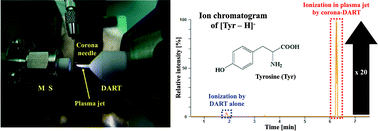Improvement in ionization efficiency of direct analysis in real time-mass spectrometry (DART-MS) by corona discharge†
Abstract
Herein it is shown that a combination of direct analysis in real time (DART) with a corona discharge system consisting of only a needle electrode easily improves DART ionization efficiency. Positive and negative DC corona discharges led to a formation of abundant excited helium atoms as well as the reactant ions H3O+(H2O)n and O2˙− in the DART analyte ionization area. These phenomena resulted in an increase in the absolute intensities of (de)protonated analytes by a factor of 2–20 over conventional DART. The other analyte ions detected in this corona–DART system (i.e., molecular ions, fragment ions, oxygenated (de)protonated analytes, dehydrogenated deprotonated analytes, and negative ion adducts) were quite similar to those obtained from DART alone. This indicates a lack of side reactions due to the corona discharge. The change in the relative intensities of individual analyte-related ions due to the combination of a corona discharge system with DART suggests that there is no effect of the abundant excited helium in the analyte ionization area on the fragmentation processes or enhancement of oxidation due to hydroxyl radicals HO˙. Furthermore, it was found that the corona–DART combination can be applied to the highly sensitive analysis of n-alkanes, in which the alkanes are ionized as positive ions via hydride abstraction and oxidation, independent of the type of alkane or the mass spectrometer used.


 Please wait while we load your content...
Please wait while we load your content...